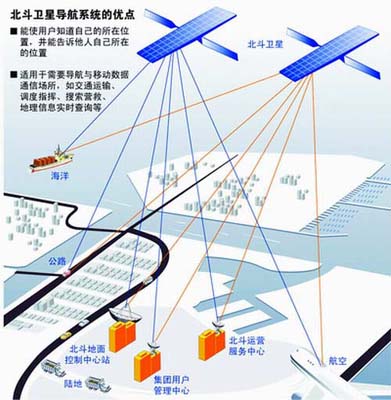|
CHINA SCIENCE AND TECHNOLOGY
NEWSLETTER
The Ministry of Science and Technology
People's Republic of China
|
|
|
N0.503 |
February 29,2008 |
|
|
|
|
|
|
|
|
IN THIS ISSUE
|
|
*High Speed Train for 350km
*Tiered Sea Level Watch System
*China’s First Master Marine Development Plan
* New Progresses on Ingaas Quantum-Well Lasers
*Core Chip for China’s Compass Navigation
* China’s First V-12 Engine
|
High Speed Train for 350km
MOST inked an agreement on February 26, 2008 with the Ministry of Railways to build a high-speed railway system that is able to run 350 km an hour. The two government agencies have jointly prepared an action plan for manufacturing China’s own high-speed trains. The action plan will work on the following four objectives: 1) based on major phase results derived from digestion, absorption, and re-innovation of imported technologies, efforts will be made to enhance the proprietary part of the technologies, securing breakthroughs in key technologies, and developing the new generation high-speed trains running 350 km an hour. This will provide a powerful support for the operation of a high speed rail between Beijing and Shanghai; 2) establish China’s own technical system for high-speed (350 km or above) rail transit with an international competitiveness, taking a lead in high-speed rail transit technologies in the world; 3) establish an innovative chain that employs the combined efforts of industry, universities, and research institutes, enhancing proprietary innovation capacity, and providing a powerful support for the sustainable development of China’s high-speed train technologies, using the combined strength of the two government agencies; 4) encourage the integration of innovation elements, facilitating the conversion of innovative findings into real productivity, fostering China’s high-speed train industrial chains and clusters, and raising China’s capacity of major equipment and facilities manufacture.
Tiered Sea Level Watch System
In 2008, China will establish a tiered sea level watch and evaluation system at the national, provincial, prefectural, and county levels, based on the existing marine watch and forecast system, said SUN Zhihui, Administrator of State Oceanography Bureau, at a national marine director conference held on February 25, 2008 in Changsha. The move will help China to understand the dynamic variation of sea levels and associated impacts, and provide scientific evidences for planning activities. State Oceanography Bureau will be responsible for the capacity building of forecast institutions at the prefectual and municipal levels, with a focus on offshore observation, operational numerical marine forecast, emergency management, and quality forecast service for the public.
SUN added that State Oceanography Bureau will work together with other authorities concerned to observe, study, and predict ocean-atmosphere interactions and climate change, and establish a basic framework for such study. It will also predict the short term climate change and associated disasters caused by marine variations, in an effort to provide a technical support for climate change related response and adaptation decision making.
China’s First Master Marine Development Plan
State Oceanography Bureau has recently issued an Outline for the National Marine Development Planning. Covering a range of management and public service areas, including marine resources, environment, ecology, economy, rights, and security, the Outline has lined up an array of missions on sustainable utilization of marine resources, marine environment and ecological protection, coordination of marine economy, marine public good services, marine law enforcement and rights, international marine affairs, and marine related S&T and education.
The Outline proposes to make China’s marine cause a digital, ecological, safe, and harmonious one, with the following missions: enhance people’s awareness of oceans, perfect marine legal system, and establish an integrated management system that is three dimensional, well regulated, fast, and fed with timely information. It also calls for strengthening international competitiveness of China’s marine industry and associated S&T undertakings. S&T community shall provide an enhanced support to marine management, marine economy, disaster prevention and preparedness, and national security, with a 50% contribution to marine economy. Meanwhile, sea water utilization shall render a 16%~24% contribution to alleviating water shortage in the coastal areas.
|
INTERNATIONAL COOPERATION |
New Progresses on Ingaas Quantum-Well Lasers
Scientists at Chalmers University of Technology in Gothenburg, Sweden and the Chinese Academy of Sciences in Beijing, China reported their latest findings on InGaAs quantum-well lasers in a recent issue of Laser Focus World. They have demonstrated that metamorphic 1.58 µm indium gallium arsenide (InGaAs) quantum-well lasers may be a promising alternative to 1.55 µm GaAs-based lasers.
With careful optimization of metamorphic crystal growth, structure, and optical properties, researchers of both nations have landed breakthroughs in addressing the growth issue of InGaAs last July, and obtained InGaAs quantum-well materials at 1.3-1.6 µm. The root-mean-square surface roughness of the 6-µm-thick laser structure, as measured by atomic-force microscope, is only 5 nm. Swedish researchers have eventually rolled out a high performance InGaAs quantum-well laser with a work wavelength at 1.58µm in an indoor environment.
Core Chip for China’s Compass Navigation

Workflow of China’s Compass Navigation Satellites
Navigation I, a core satellite navigation chip developed by Shanghai Hualong Microsystem Co. Ltd. for China’s Compass navigation satellite, has recently called a success. The wholly localized chip enjoys a performance and a cost that are both competitive with similar products manufactured overseas. The novel chip is of an important defense and economic value, as it can be used in a wide range of areas, including sea-land-air traffic control, wire and wireless communication, geological prospecting, resources survey, forest fire fighting, medical emergency, marine retrieval and rescue, precision measurement, and target watch.
Not long ago, China successfully blasted off a second generation Compass navigation satellite, part of the navigation network consisting of 5 geostationary satellites and 30 non-geostationary satellites. China is picking up its speed to turn more navigation satellites into practical applications.
Dropsonde
SCHeREX, a field experiment for heavy rain initiated by the Chinese Academy of Meteorological Sciences, will drop radiosonde from aircraft for the first time in the country, in an attempt to observe moving mesoscale heavy rain bands and typhoon migrating from tropical oceans. According to a briefing, a dropsonde is designed to collect 3-D meteorological data with high spatial and temporal density. It can be used to collect needed high precision data in a scarcely populated area or over a sea surface. The mobility of dropsonde allows scientists to track down severe weather systems in a three dimensional manner, which is important for studying the mesoscale strong convective system and typhoon system. Comparing with the land launched radiosonde, the dropsonde can be used in any sensitive area to collect reliable data of mesoscale elements, including temperature, humidity, air pressure, and winds.
Joint Test for New Spacecraft
YANG Baohua, President of China Academy of Space Technology, said on February 20, 2008 that China has successfully completed a joint test of airlock module and astronauts in space suit on the ground.
According to a plan, Shenzhou 7 capsule membered with three astronauts will be launched at the Jiuquan Satellite Launch Center in the year. Chinese astronauts will make their first space walk. The proprietary new spacecraft is believed a match against the latest spacecraft made in the world. Made up of an orbital module, a re-entry capsule, and a propelling module, the spacecraft will lift three astronauts into space in a re-entry capsule that is 2.5m across, or the largest reusable aircraft in the world. After the re-entry capsule returning to the earth, the orbital module will stay in orbit for several months, working on scientific and technological experiments. The launch and flight of the novel aircraft will allow China to test a range of space technologies, including space walk, mounting on a step towards establishing China’s own space station in the future.
China’s First V-12 Engine
CA12GV, China’s first V-12 engine developed by China No. 1 Auto, has recently made its successful ignition at the Technical Center of the automaker. The novel engine is of the following technological edges and improvements: 1) advanced combustion system for both intake injection and fuel stratified injection; 2) combined work of master/slave ECU, allowing a precision control of engine performance, emission, and whole car; 3) double VCT for optimized fuel economy, dynamism, and emission; 4) three-level noiseless chain transmission, for optimized NGH performance; 5) full aluminum light weight design, for a best balance between light weight and NVH performance; 6) advanced NVH design, with special designs for individual car components and parts, ensuring an improved noise performance; and 7) a TOP-DOWN compact engine structure, allowing a most economic possible size.
Picosecond and Low-Power All-Optical Switching
A research finding on ultrafast and low-power photonic-crystal all-optical switching based on strong optical nonlinearity enhancement, worked out by a research team led by Prof. GONG Qihuang, the State Key Laboratory for Mesoscopic Physics under Peking University Department of Physics, was published in a recent issue of Nature Photonics. The study has produced the following three findings. First, a composite material made of organic chromophore and polymer was used as the matrix for the photonic crystals. Second, a pump light at a frequency within the absorption band was used to excite the composite material. The composite material provides a very large nonlinear optical coefficient under near-resonant excitation, which leads to an ultralow pump power and large switching efficiency. The nonlinear coefficient is two orders of magnitude larger than that when only polymer material is near-resonantly excited. Third, the interelectron transfer process between the chromophore and polymer ensures an ultrafast response time. This approach provides a strategy for constructing photonic materials with large nonlinearity and studying ultrafast low-power integrated photonic devices.
MOST Launches Monorail Project

Test run of straddle monorail transit vehicle in Chongqing.
The Chinese Ministry of Science and Technology (MOST) kicked off on February 26, 2008 an R&D project in Chongqing to work on the key technologies needed for establishing a straddle monorail transit system in the city. As an initiative under the National S&T Support Program for the 11th Five-year period (2006-2010), the project will work on 10 research missions, including industrialized manufacture of monorail vehicles, support facilities for a monorail transit system, and monorail transit safety. It is supposed to produce the said ten key technologies, and a localization of 70% in a time of four years.
Xianan Crossbreds a Success

Measuring a Xianan crossbred.
Not long ago, China National Committee on Genetic Resources of Domestic Animal has identified Xianan crossbreds China’s first beef species. The new species, grown in the Miyang County, Henan Province, is crossbred with French Charolais, using the genes extracted from Nanyang beef in the locality.
Umbilical Mesenchymal Stem Cells
An umbilical cord mesenchymal stem cells bank, established by Tianjin based AMCELLGENE, has successfully stored some 5000 umbilical cord mesenchymal stem cells in its bank, after more than one-year operation.
AMCELLGENE has mastered the technology to separate mesenchymal stem cells from human umbilical cords for the first time in the world, and made it a patent. It also established the world’s first mesenchymal stem cells bank using the technology, and rolled out an injection using the stem cells to treat a range of diseases, including heart disease, paralysis caused by nerve damage, and repulsion reaction after hematopoietic stem cell transplanting.
3-D Magneto Saves Power by 50%
A 3-D magneto, developed by Prof. YE Yunyue of Zhejiang University Institute of Electric Engineering, has registered a reduced no-work consumption by 92.5%, and a reduced power consumption by 50% or more.
Prof. YE explains that the new magneto is completely different from the existing magnetos. The broad application of new magneto may produce an annual economic saving worth RMB 10 billion. The project, financed by Zhejiang Provincial S&T Program with a sum of RMB 1 million, has filed 7 invention and utility patent applications, with 5 of them being granted. The magneto has been put into production in Beijing, with orders flown from the Daqing Oilfield.
Comments or inquiries on editorial matters or Newsletter content should be directed to:
Mr. XU Chaoqian, Department of International Cooperation, MOST 15B, Fuxing Road, Beijing 100862, PR China Tel: (8610)58881360 Fax: (8610) 58881364
http://www.most.gov.cn |

